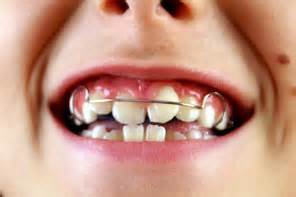Interceptive Orthodontics: An Early Detection and Opportunity For Your Child’s Beautiful Smile
Posted by admin on May 1, 2014 in Blog | Comments Off on Interceptive Orthodontics: An Early Detection and Opportunity For Your Child’s Beautiful Smile
Interceptive Orthodontics:
An Early Detection and Opportunity For Your Child’s Beautiful Smile
By Dr. Kao Pediatric Dentistry
It used to be a common practice to evaluate a child’s need for braces starting when they are pre-teens. Now The American Association of Orthodontists (AAO) recommends that every child be evaluated by an orthodontist or dentist no later than age 7 and sometimes younger. Dentists have discovered that early intervention may actually prevent future problems with the mouth, jawbone and bite. This early intervention is called interceptive orthodontics, a treatment that is performed by a dentist. Early evaluation provides both timely detection of problems and greater opportunity for more effective treatment. Appropriate intervention can influence growth and development, preventing more serious problems later.
The principle of interceptive orthodontics is to “intercept” or prevent bite problems. Dentists recommend interceptive orthodontics for many reasons. One of the most common reasons is to correct issues caused by thumb sucking or pacifier habits. Using pacifiers or thumb sucking can reshape the jawbone causing teeth to grow in crooked, especially the front teeth. Over time, this can make front teeth more susceptible to injury and make a child self-conscious about their appearance and smile.
For babies and teens, the goal for interceptive prevention is to provide adequate space for permanent teeth to come in. Treatment may require a space maintainer to hold space for a primary (baby) tooth lost too early or removal of primary teeth that do not come out on their own in order to create room for permanent teeth. To allow severely crowded teeth to move on their own into much more desirable positions, sequential removal of baby teeth and permanent teeth (usually first premolars) can dramatically improve a severe crowding problem allowing the child to have excellent function and a more attractive looking smile.
The purpose of interceptive treatment is to guide the permanent teeth into their correct position and to facilitate proper growth and development of the jaw.
- These are some of the specific goals of interceptive treatment:
- Create room for crowded, erupting teeth
- Preserve space for permanent teeth that will erupt and reduce the likelihood of impacted permanent teeth
- Establish facial symmetry or balance by modifying jaw growth
- Harmonize the width of the dental arches
- Eliminate cross bites that, if uncorrected, may negatively affect growth of the jaws or cause premature wear on the teeth
- Lower the risk of trauma to protruding front teeth
- Reduce the need for tooth extraction in the future
- Simplify and/or shorten treatment time for later corrective orthodontics
- Improve some speech problems
- Correct harmful oral habits
- Improve self-esteem
Believe it or not, Pediatric Safety introduced an article regarding how preventative orthodontics within interceptive treatment can help with sleep. This article, ADHD, Interceptive Orthodontics and Children is a wonderful resource if you are researching interceptive treatments for your child.
http://www.pediatricsafety.net/2013/08/adhd-interceptive-orthodontics-and-children/
What kinds of orthodontic appliances are typically used to reduce the severity of jaw-growth problems?
The decision regarding the use of an appliance for this type of correction is based on the individual patient’s problem and requires an evaluation with your dentist. Some of the more common orthopedic appliances include:
- Fixed functional appliance – The appliance is usually fixed (glued) to the upper and lower molar teeth and may not be removed by the patient. The appliance can help correct severe protrusion of the upper teeth.
- Headgear – This appliance applies pressure to the upper teeth and upper jaw to guide the direction of upper jaw growth and tooth eruption. The headgear may be removed by the patient and is usually worn 10 to 12 hours per day.
- Palatal expansion appliance – A child’s upper jaw may be too narrow for the upper teeth to fit properly with the lower teeth (a cross bite). When this occurs, a palatal expansion appliance can be fixed to the upper back teeth. This appliance can markedly expand the width of the upper jaw. For some patients, a wider jaw may prevent the need for extraction of permanent teeth.
Interceptive treatment is followed by a resting period in which the child usually wears some form of retainer while the remainder of the permanent teeth is allowed to grow in. After the permanent teeth begin to erupt, comprehensive treatment with full braces is generally necessary to align the teeth and achieve a proper bite for optimal esthetics and function. In rare instances, comprehensive treatment is deemed unnecessary because a reasonable alignment and functionality of the teeth has occurred following interceptive treatment.
When looking at oral jaw and teeth preventative maintenance for your child, please remember to seek consultation from Dr. Kao. His practice offers interceptive treatment options that can provide a more pleasing, confident, and beautiful smile for your children. For more information regarding this type of oral health care call (650) 755-0277.

